#original oratory
Photo
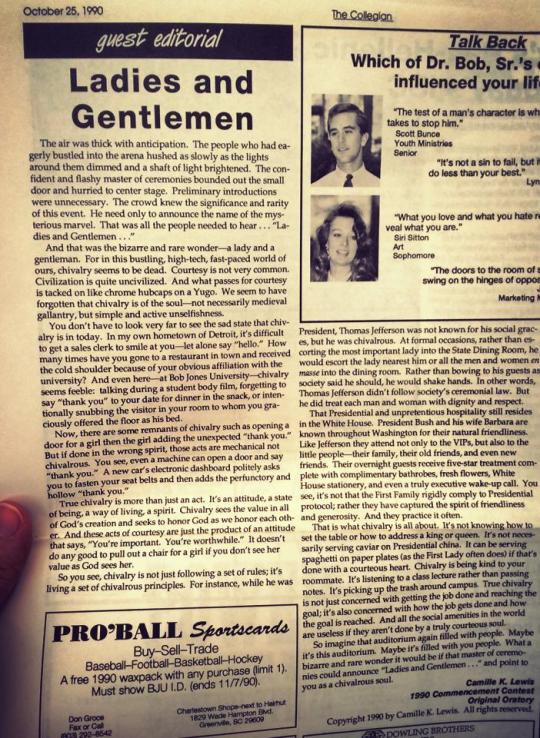
In 1990, I won the Original Oratory competition. The next Fall the Collegian printed the text in full.
Note the copyright. I was a badass even then.
1 note
·
View note
Text
I was at a debate competition yesterday, so here's some art of the chain based on that. This is a debate au now ig?
Lu-tober day 15+16
No prompt
Debate AU lmao

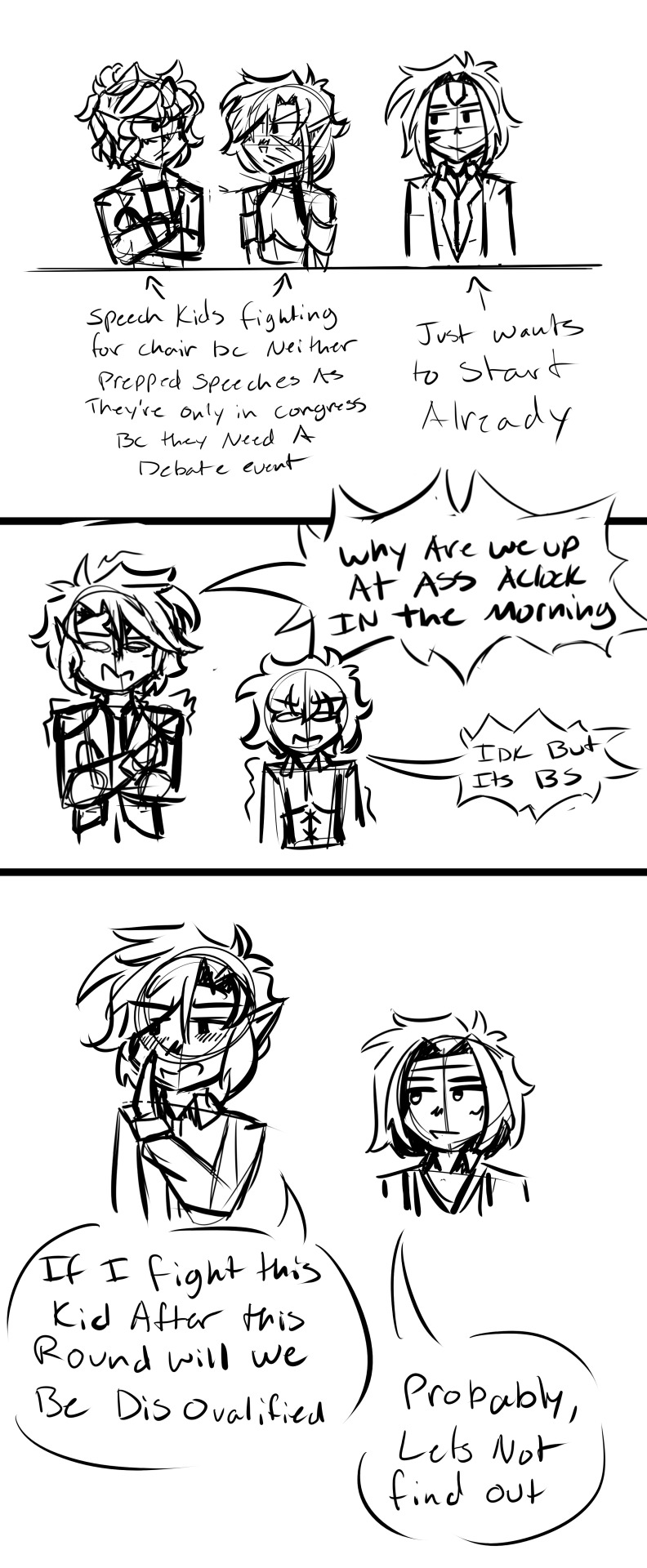

Anyway highlights from the trip + bonus info
Had to get up at like 3:45 am, had to be their at 4:45 and then hours of drive time it was some bullshit no one was happy also it was cold as fuck
Wild and Hyrule being in Congress bc they're speech kids and need a debate even is so me tho. I crashed and burned cause I had not a single thing prepared lmao
Turned Legend and Four into a PF duo cause they gave me the same vibe as a pair of people on my team, also I think it'd be funny
I won first place with my Oratory! Wasn't actually expecting that, but I got straight 1's through all my rounds, was very confused at first but hey I slay :D
Last comic bit of Wild winning is basically a recreation of that moment expect there was more exited running and fistbumps as I returned to the audience
Probably never gonna touch this idea again but I find it amusing for now. Maybe one or two bored doodles during rounds.
#lutober#lu legend#lu wild#lu hyrule#idk what to tag this#anyway debate seasons starting I am dreading it yet very exited#Oh random notes about this#Wild does informative speaking#Which was my old event before a topic switch into oratory#Sky and Wars do LD. Wind does Extemp and Humorous Interps.#Originally I had Twi and Time put down as a Policy team and TBH I kinda think they still should be#I just wanted someone to throw in congress with the other two#It was originally Wars but I decided I didn't wanna draw him#Sorry wars#Can you tell I've though about this too much?#I got very bored during my Congress Round#Also didnt get murdered by ghosts hell yeah :D
32 notes
·
View notes
Text

30 notes
·
View notes
Text
A writer’s guide to the historical method: how historians work with sources
In this post, I provide a brief overview of how historians engage with different types of sources, with a focus on the mindset of a historian. This insight could be valuable for anyone crafting a character whose profession revolves around history research. It may also prove useful for authors conducting research for their book.
Concept of historical source
The concept of historical source evolves over time.
Initially, the focus was mainly on written sources due to their obvious availability. However, as time has progressed, historians now consider a wide range of sources beyond just written records. These include material artifacts, intangible cultural elements, and even virtual data.
While "armchair historians" may rely on existing studies and secondary sources, true professional historians distinguish themselves by delving directly into primary sources. They engage in a nuanced examination of various sources, weaving together diverse perspectives. It's crucial to recognize the distinction between personal recollection or memory and the rigorous discipline of historical inquiry. A historical source provides information, but the truth must be carefully discerned through critical analysis and corroboration.
Here's a concise list of the types of sources historians utilize:
Notarial source
Epistolary source
Accountancy source
Epigraphic source
Chronicle source
Oratory and oral source
Iconographic source
Diary source
Electronic source
Example: a notarial source
These are documents drafted by a notary, a public official entrusted with providing legal certainty to facts and legal transactions. These documents can take various forms, such as deeds, lawsuits, wills, contracts, powers of attorney, inventories, and many others.
Here we are specifically discussing a lawsuit document from 1211 in Italy.
A medieval lawsuit document is highly valuable for understanding various aspects of daily life because in a dispute, one must argue a position. From lawsuits, we also understand how institutions truly operated.
Furthermore, in the Middle Ages, lawsuits mostly relied on witnesses as evidence, so we can access a direct and popular source of certain specific social situations.
Some insight into the methodology of analysis:
Formal examination: historians scrutinize the document's form, verifying its authenticity and integrity. Elements such as structure, writing style, language, signatures, and seals are analyzed. Indeed, a professional historian will rarely conduct research on a source published in a volume but will instead go directly to the archive to study its origin, to avoid transcription errors.
Content analysis: historians proceed to analyze the document's content, extracting useful information for their research. This may include data on individuals, places, events, economic activities, social relations, and much more. It's crucial to compile a list of witnesses in a case and identify them to understand why they speak or why they speak in a certain manner.
Cross-referencing with other sources: information derived from the notarial source is compared with that of other historical sources to obtain a more comprehensive and accurate view of the period under examination.
Documents of the episcopal archive of Ivrea
Let's take the example of a specific legal case, stemming from the documents of the episcopal archive of Ivrea. It's a case from 1211 in Italy involving the bishop of Ivrea in dispute with Bongiovanni d'Albiano over feudal obligations.
This case is significant because it allows us to understand how feudal society operated and how social status was determined.
The bishop's representative argues that Bongiovanni should provide a horse as a feudal service. Bongiovanni denies it, claiming to be a noble, not a serf. Both parties present witnesses and documents supporting their arguments.
Witnesses are asked whether the serf obligations had been endured for a long time. This helps us understand that in a society where "law" was based on customs, it was important to ascertain if an obligation had been endured for a long time because at that point it would no longer be contestable (it would have become customary).
The responses are confused and inconsistent, so witnesses are directly asked whether they consider Bongiovanni a serf or a noble. This is because (and it allows us to understand that) the division into "social classes" wasn't definable within concrete boundaries; it was more about the appearance of one's way of life. If a serf refused to fulfill his serf duties, he would easily be considered a noble by bystanders because he lived like one.
Ultimately, the analysis of the case leads us to determine that medieval justice wasn't conceived with the logic of our modern system, but was measured in oaths and witnesses as evidentiary means. And emerging from it with honor was much more important than fairly distributing blame and reason.
Other sources
Accounting source: it is very useful for measuring consumption and its variety in a particular historical period. To reconstruct past consumption, inventories post mortem are often used, which are lists of goods found in households, described and valued by notaries to facilitate distribution among heirs.
Alternatively, the recording of daily expenses, which in modern times were often very detailed, can lead to insights into complex family histories and their internal inequalities - for example, more money might be spent on one child than another corresponding to their planned future role in society.
Oral source: in relation to the political sphere, it is useful for representing that part of politics composed of direct sources, that is, where politics speaks of itself and how it presents itself to the public, such as a politician's public speech.
However, working with this type of source, a historian cannot avoid hermeneutic work, as through the speech, the politician aims to present himself to a certain audience, justify, persuade, construct his own image, and achieve results. This is the hidden agenda that also exists in the most obvious part of politics.
Iconographic source: it concerns art or other forms of "artistic" expression, such as in the case of an advertising poster. They become historical sources when it is the historian who, through analysis, confers upon them the status of a historical source. Essentially, the historian uses the source to understand aspects of the past otherwise inaccessible.
The first step in this direction is to recontextualize the source, returning it to its original context. Examining the history of the source represents the fundamental first step for historical analysis.
Diary source: diaries are a "subjective" source, a representation of one's self, often influenced by the thoughts of "others," who can be close or distant readers, interested or distracted, visible or invisible, whom every diary author can imagine and hope to see, sooner or later, reflected on the pages of their writing.
Furthermore, they are often subject to subsequent manipulations, and therefore should be treated by historians only in their critical edition; all other versions, whether old or new, foreign or not, are useful only as evidence of the changes and manipulations undergone over time by the original manuscripts.
Electronic source: historians use Wikipedia even if they often don't admit it out loud.
This blog is supported through tips here on Tumblr. If you’d like to support me, please consider giving a tip.
#writing advice#writing help#writing reference#writing tips#creative writing#fantasy worldbuilding#fantasy writing#worldbuilding#worldbuilding tips
295 notes
·
View notes
Text
Coaching district speech today — one of my freshman finished her original oratory piece, said “I did it? :)” and instantly burst into tears.
278 notes
·
View notes
Text
Toman and Buddhism + Tenjiku and Taoism
Another post to cover references in Tokyo Revengers!
This time, I'll be covering the links to two religions to be found in two gangs in the series, reference by reference, with the according explanation of each.
Some of these may be already known, I know one of them sure is (the whole buddhist manji confusion thing yeah yeah) but still, for the sake of a tidy compilation and of providing more detail, I'll go through them too. Some others are a lot less noticed, like Tenjiku's lean towards Tao, so it'll be best to lay down eeeeeeverything I've caught during my time enjoying this series. Plus, I'm pretty excited to get some of those less-known facts out here!!
Warning though, it's lengthy.
Let's start with Tokyo Manji Gang:

- Firstly, the gang's name and how it's written.
Despite Mikey suggesting the name as a short form of Tokyo Manjiro Gang, putting himself front and center, the kanji that ended up forming the name of Tokyo Manji Gang show that it went in a different direction of meaning. The manji used for the middle part ended up not being the same one from the name Manjiro, but a manji written as 卍. Aloud it's read the same way (many, many, many kanji are homophones), but has a different meaning.
卍 (manji) is an extremely common buddhist symbol (not even limited to japanese buddhism, but in hinduism and other aligned east-asian religions too), which represents the path of Buddha and the endless cycle of rebirth through samsara; the pursuit of leading a more spiritually balanced existence until the soul can reach enlightenment. In other words, it's nothing but deeply buddhist.
(To answer a common question around it: can it be called a swastika? Yes. The symbol in general, with each of the million variations that have popped up in different cultures, can be called a swastika as a broad term. There are a fuckton of swastikas. They mean a fuckton of different things. The tilt and the direction in which this one "spins" makes it different from other swastikas though, and it's always best to be precise and call this one manji.)
Moving on,
- Reunion spot.


The Musashi Shrine (based, but not exactly taken from any of the real-life shrines and temples of similar name in Tokyo, as far as I know) is a shinto-buddhist temple. And, apparently, a place where the founders hung out from time to time, but I'll add to that later!!
It's cute to me that the Toman members seem to use the temple very respectfully. They always meet in it at night waaay after it's closed (daytime meetings have always taken place in different locations, never the temple during visiting hours), they've never once set foot even near the oratory/sanctum/other buildings, never been seen bringing the motorcycles anywhere they shouldn't, and the one time a character was seen using the public temizuya (the little stone fountain where visitors purify their hands and mouth), he was proper about it in terms of pouring water into his hand to rinse his mouth with, not getting the ladle or the rest of the water dirty, as one should always do.
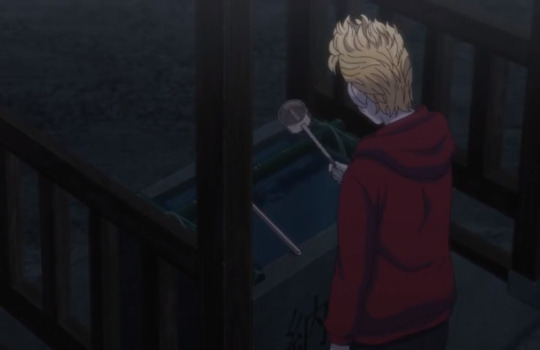
A fun fact: in Google Maps, buddhist temples are marked with the manji symbol!
- Gang's manifesto.

Embroidered on the chest of the gang uniform, you can see the text 天上天下唯我独尊 ("Above the earth and below the heavens, I alone shall be honored"), which is the gang's manifesto or motto. Sounds just like something Mikey would choose, yeah.
That phrase is also of buddhist origin; famously, the words spoken by Buddha Gautama Siddharta (bear in mind that buddhism isn't a religion with one god or anything like that, anyone enlightened can become a Buddha and many figures have been granted that status, but Gautama is the first and main one, the creator of the doctrine) when he was born. To be honest, this is very much interpretative, but I've come to get the impression that it's not so much a power or ego statement, but rather an expression of cultivating and honoring yourself…? It's absolutely up to personal reading and I'm absolutely not an expert. But those are certainly THE Buddha's words.
- Ceremonial sash.

Another part of their uniform that bears a slight reference: the sash worn by the commander, vice-commander, captains and vice-captains during important fights.
These are tasuki, sashes originally worn by shinto-buddhist priests during ceremonies, in order to keep long sleeves and such in place. However, eventually, they also began being worn by samurai and all sorts of warriors, 'cause of their convenience. In modern times, they even started being used by just about anybody who wears traditional clothing but also does manual work and needs the sleeves out of the way. So it can be concluded that, over time, they stopped being strongly linked to religious practicers. In fact, even biker gangs in general ended up adopting the use of tasuki! Not for their religious origins, but for the warrior part; a bōsōzoku gang member wearing one would look very prepared and determined for a fight.
That's why overall, Tokyo Manji Gang having them is only a relative reference; they could be paying homage to their reference religion, as they could be only honoring gang traditions.
- Additional notes about the leader.
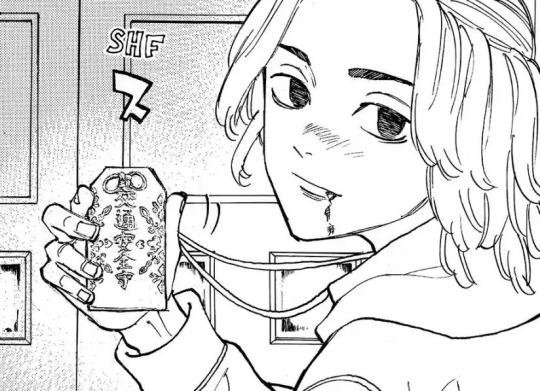
I feel it's important to add up all these little factors of Mikey's choosing, with other little details about him as a person that kinda make it all make sense.
If I say "Mikey seems to be religious, to an extent", I understand this can carry a bunch of tricky connotations. Japanese religion isn't exercised the same way it is in other places, someone being religious SURE AS HECK doesn't mean the same things it means in the christian west. Shinto-buddhism is so commonplace in Japan, most people partake in all kinds of religious practices without even thinking of them as strictly religious, such as new year's celebrations, casual prayer during shrine visits, purchasing and giving charms and such. Religion is integrated in life in a lot of extremely chill ways.
And we can observe a lot of things about Mikey that put him quite above the average in terms of his relationship with local tradition and religion. His house is a huge traditional-style family home, his family is hinted to be active in religious practice (remember Emma's appearances during the Christmas Showdown arc? How she mentioned that their family does a lot of temple visits, and even she considered it weird at that time of the year?), he's much more prone to wearing traditional clothing than his peers, his motif in extra clothing designs is the lion-dog (temple guardians; statues of these can often be found in them), his personal beliefs around death and relationship to the dead run deeper than others' to the point they find him disturbing when he talks about Shinichiro or Baji still being with him... many little things that aren't that deep on their own, of course, but when added up they paint a pretty coherent picture of the guy.
And so, it does make a lot of sense that, even from childhood, a temple was a regular place for Mikey to hang out with his friends, leading to the birth of Toman in one. And it makes a lot of sense that he made all those little choices about the way the gang would be styled. In my opinion, it's likely that those things just all came natural to him because they're a part of his background and worldview. Of course, how actively religious he is, how much he believes in the things he happens to know and how much exactly he might know about buddhism are all up to headcanoning and interpretation. Personally, I'm just a roleplayer that takes it as a relevant part of his character.
- Following a Buddha?
A little out-of-TR-universe element that I love to bring up, 'cause it's just hilarious and cool as hell, is the creation of this statue:
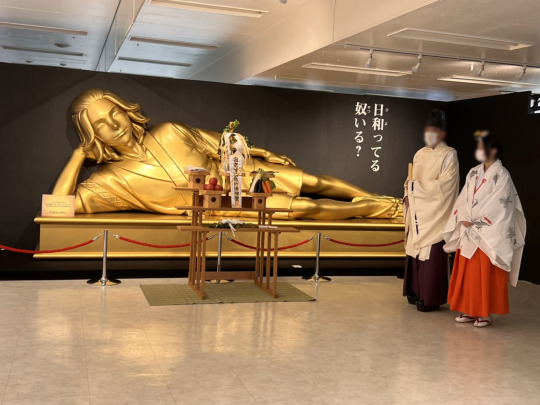
This part of the 2022 Tokyo Revengers exhibition straight up imitates the famous Reclining Buddha in the Wat Pho temple, Thailand.
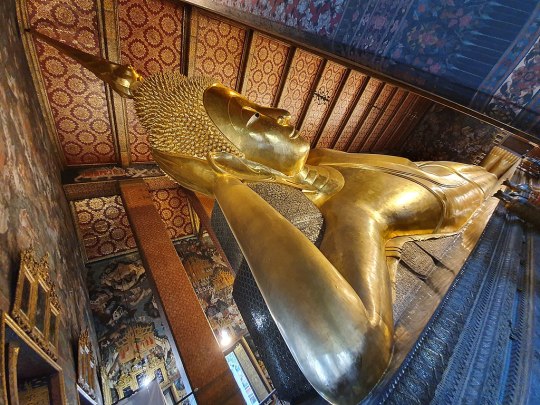
The ENORMOUS statue depicts the moment Buddha reaches nirvana, and his enlightened soul is at rest. The golden Mikey statue that imitates it very much intentionally likens him to a Buddha; funny to note that the exhibition staff even prayed to the statue, as you can read in the tweet itself.
What does this mean about Mikey's character? Well, this isn't within text in Tokyo Revengers, just a little outside factor, so I wouldn't take it too literally or too seriously, but it's interesting nonetheless. Personally, I see it as a hint that Mikey was supposed to be on his own little quest to enlightenment, or had the potential to be. Grappling with morality without having a natural sense of what's right, wrong, too much or enough is a major thing with his character. I can also imagine it might just be meant to represent the godlike view others have of him, the guidance they sought from him. Take it as you will!
The important thing is just that it exists, to confirm that there is an intentional connection of some type between the Buddha and Mikey.
Thaaaaat concludes the Toman and Buddhism section of this post.
Whew!! That was a whole lot.
The Tenjiku and Taoism section coming now is shorter, but I'm sure it contains interesting and less-known things (at least, I've never seen anybody talk about these)!
So let's see, Tao references in Tenjiku:

- Gang name.
Tenjiku is a now-obsolete word that translated directly to "heaven", while simultaneously being the japanese word for the country India (as taken from the chinese pronunciation, Tianzhu).
In modern times, it can be found mostly in ancient literature, the most prominent example being Journey to the West. Given that Kakucho and Izana mentioned this book and seemed to have knowledge of it as kids, we can conclude that's where they got the name of their gang from.
Why would they use the word for India to name their kingdom? What does this have to do with Tao? I'll get into that properly now:
- Kakucho, Izana & Journey to the West.

Journey to the West is one of the four great chinese classic novels (along with Romance of the Three Kingdoms, Outlaws of the Marsh, and Dream of the Red Chamber) which are enormous, ENORMOUS influences on east-asian literature and fiction in general. Journey to the West, itself, is considered the most popular east-asian literary work overall; of course, being super well-known in Japan, too. (To give my favorite funny example of just how omnipresent it is, y'know Dragon Ball? Hit anime series Dragon Ball? Unabashedly based on Journey to the West, which was to thank for most of its initial local popularity.)
It's the story of the buddhist monk Tang Sanzang, who travels to Tenjiku, to India, to that certain heavenly kingdom, to obtain sacred texts for Buddha Gautama Siddharta (the guy I described as THE Buddha in the Tokyo Manji Gang section above). The quest doubles as a search and exercise of enlightenment, as Tang Sanzang is aided by three protectors that are atoning for their sins and learning from him. The main guardian and arguably the true protagonist of the book is Sun Wukong, the Monkey King, a fighter "so strong he could carry a mountain on each shoulder, and still dash as fast as a meteor". It's a huge, epic, 100-chapter monster of a book, in which each chapter is already a fantastic and entertaining anecdote about the characters or what happens in their travels, but also a long spiritual journey that pretty much serves to subtly teach the principles of Tao (term that can be translated to "the path", chinese religion and philosophy).
A tangent: let me just show you how large it is (and why I haven't been able to finish it, 'cause I cannot take this brick of a book anywhere lmaoooo).
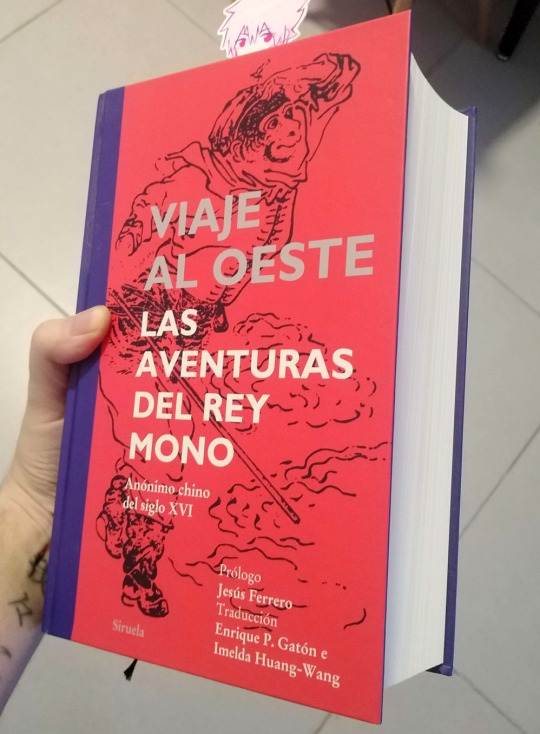
(Cover says Journey to the West: The Adventures of the Monkey King. It's in spanish.)
My guess is that Izana and Kakucho studied about it or read some chapters in school, 'cause dang, there's no way they read all of this at that age?!?! BUT ANYWAY.
While there's obviously quite some buddhist influence in the story, most of what it works with throughout is rooted in chinese folklore and Taoism. The edition of the book I have even begins with extensive notes and introductory explanations about Tao, as its themes of harmony with the universe, self-cultivation, internal alchemy, its main ethics and values, etc etc etc are the basis from which the book is built up. The characters very actively engage with Tao. Sun Wukong is an ardent student of Tao who obtains a bunch of powers through it, for one.
I've gone into this much into detail because Kakucho and Izana make it pretty explicit that, to them, Izana is like monk Tang Sanzang leading to Tenjiku, and Kakucho is like his guardian of unmatched strength, Sun Wukong.
In the end of Journey to the West, it's both Tang Sanzang and Sun Wukong that accomplish their goal and also obtain enlightenment, finally ascending to buddhahood. Had Izana and Kakucho's journey with Tenjiku reached their original destination (not "to become a criminal syndicate that controls Japan" but "to build a kingdom where everyone without a home could exist"), had it been like Tang Sanzang and Sun Wukong's pilgrimage… they would've learned true balance and they would've found the necessary enlightenment.
Again, I find this little connection with characters that could've been on a quest towards buddhahood, but as far as things went in the main TR timelines, all failed.
- Uniform & logo.
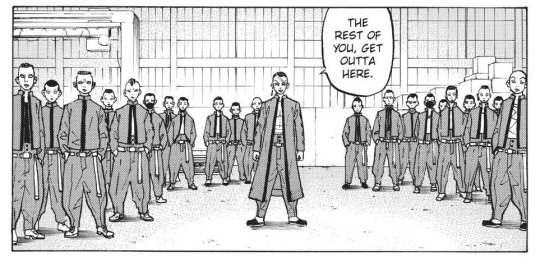
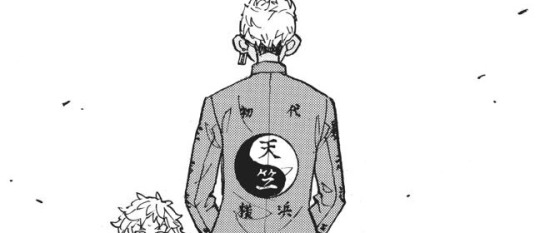
Finally, something lighter and quicker to add, haha.
There are symbols and references that are so so so widespread that they become more of an aesthetic detail than a symbol with meaning, in the eyes of the general public. The yin-yang is one of those symbols that just… appears in a lot of places, fashionably, and one kinda gets used to seeing it without thinking much about it. Sometimes it's not meant to stand for much more than a decorative detail, yes, that definitely happens, but sometimes it's very much a thoughtful choice. With Tenjiku, given its connection to Taoism, I'm gonna treat the yin-yang as a meaningful choice.
So! On the back of the uniform we have a yin-yang, Taoist symbol that represents the balance of the two complementary and opposing forces of the universe (note: it's not a good vs evil type of thing, as tends to happen with western black-white dualism, but rather… the fact that reality needs to be composed of push and pull to get anywhere, hard and soft things with their own function, sun and shade. A common comparison is how a mountain will have a sunny side and a shady side when looked at in a certain moment, but the sun and shade will switch over at another time of day, in a needed cycle). Other features of the uniform are a mao collar instead of a more common style for gang jackets, and an intense red color, the main auspicious and prosperous color in chinese culture. These last two little features could easily be coincidental, but when paired with the yin-yang, I feel like it's intended to lean towards chinese aesthetics.
And with that,
I end this reference post!
Did you learn anything you didn't know? Did you enjoy learning it? Any thoughts? I LOVE TO TALK ABOUT THESE THINGS, SO FEEL FREE TO DROP BY MY ASKBOX with any comments or questions or such!!
#tokyo revengers#tokyo revengers meta#tokyo manji gang#toman#tenjiku#kurokawa izana#sano manjiro#izana kurokawa#manjiro sano#mikey#kakucho#thoughts and talk and so#tokyo rev#wanted to write this one forever#just never quite got around to it
166 notes
·
View notes
Text
I was planning on writing something serious about Gale...but this came out instead. I have no idea why I'm posting something so unhinged. It's only Gale that make me this way. I sincerely believe Gale is a switch at heart, but since I've seen many wonderful treatises on bottom Gale I think I'll do the other side.
In this post I shall prove why Gale would make a great Dom/top and what I think he'd enjoy. NSFW.
This man is compassionate, open-minded, empathetic, and interested in your pleasure. He is a consent god. All traits of a S-tier dom. He'd be the supportive yet firm type. It's not only Halsin that exudes that energy, I think Gale does too! In my experience types like Gale are usually very good at it. Being a good top requires a good base of knowledge of the human psyche and anatomy. You're basically a sex nerd hacking brain chemicals while doing elaborate roleplay, and Gale is no stranger to research, and taking notes. You need good empathy to gain insight on your partner and feel what they might be feeling. It's very important for knowing when to stop. Being interested in your pleasure means he won't be purely taking. Good play to me is all about swapping and blending each other's energy and being a two-way street.
You always liked the idea of being worshipped. Adored. Obeyed...
This is a line from origin Gale that the player can choose. This man wants to be a god. He wants to be worshipped, and if he can't get that in the form of godhood I don't see why that can't be indulged elsewhere...
Speaking of indulging, when you tell Gale you prefer him naked at the party, he'll reply "I'll be sure to indulge you when you get home." with a smirk. And the teasing kiss where you are denied until Gale reciprocates is prime control material. He would enjoy teasing and denial.
He's a giver because he wants you to come undone and into a puddle of mess. He wishes to find your limits, what makes you tick and what doesn't. He will study every reaction, every weakness...and use it against you. He is an artist and your sounds of pleasure his notes in his newest piece. Gale would enjoy using his oratory talents to overstimulate you to tears, hands gripping your legs tight so you can't escape. You'll be teetering on the edge of wanting him to stop, but he never crests over the limit.
Look at the astral scene! He didn't lose concentration the whole time. Gale would love long elaborate scenes involving illusions. He enjoys showing you the wonders and limits of magic, things you've never seen before. The reassuring way he tells you to not be afraid because he's here with you during the boat scene is the exact tone he'd use while blowing your mind. Imagine the tools he will have at his disposal. Evrad's black tentacles? Mage hand? Simalcrum?
He's a teacher at heart, and have you heard the way he says "very good" during the weave teaching scene?? This man will be using praise and encouragements when you're most vulnerable. Gale enjoys positive reinforcement to get you to submit. Why use harsh words and punishments to get things done, when he can make you kneel all on your own? His buffing lines includes things like "Go on, excel" and "make me proud", and you do so very want to make him proud.
You just know he's great at aftercare. He's the only one to even think of bedding while bedding you, after all. He will always have reassuring words, or a fun joke to break the tension, and plenty of fluffy blankets on a warm bed.
In conclusion, Gale (especially postgame mortal Gale) would be great as a dom and thank you for coming to my unhinged Ted talk. *Bows*
#gale thoughts#Dom Gale propaganda#gale dekarios#gale of waterdeep#bg3 spoilers#hornyposting#Gale headcanon
332 notes
·
View notes
Text
I recently found my original oratory about Bury Your Gays that I wrote back in high school circa 2016. It's not great, but it has some great points

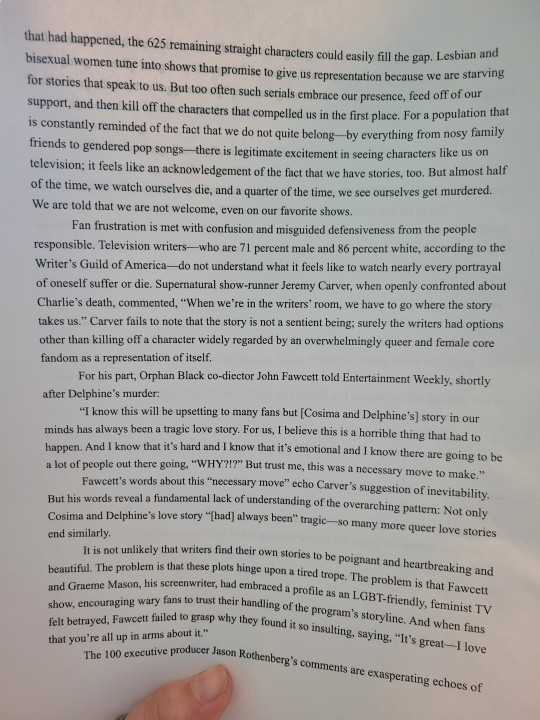

#buffy the vampire slayer#the 100#clexa#clarke griffin#commander lexa#supernatural#charlie bradbury#bury your gays#orphan black#delphine brunner#tara maclay
11 notes
·
View notes
Text

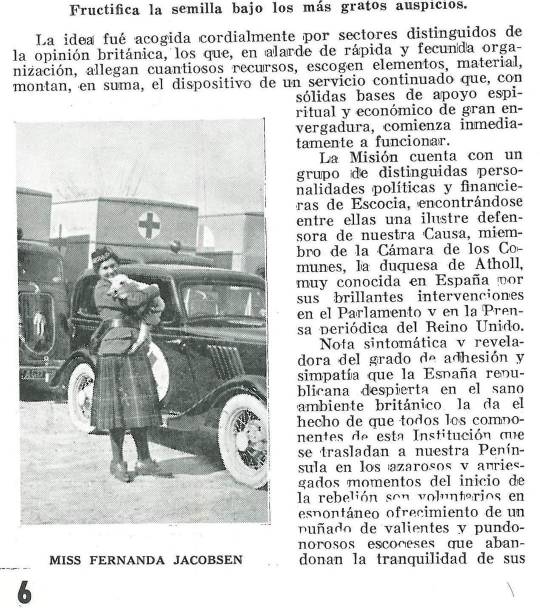
On April 10th 1936 Activists including the 'Red Duchess of Athol' formed a committee to send an ambulance to Spain in memory of three Dundonians killed while fighting for the Spanish Republican government.
A remarkable Scottish woman of principles.....
I’m using this wee bit of history to actually tell you about one of the woman in particular here, I will touch on the Ambulance story during the post, but in the main it’s about one remarkable lady
The Red Duchess, or Katherine “Kitty” Murray, the Duchess of Atholl, as she was formally known, was Scotland’s first female MP, The Red Duchess tag is a bit of a misnomer, as Kitty was a Tory politician, but beffore you judge her on this, please don’t hold that against her though, read the post and then judge her.
Kitty shook up parliament with her high principles and disregard for old school tribal politics, she joined the House of Commons in 1923 after winning the seat of Kinross and West Perthshire for the Conservatives. She also realised the threat Hitler posed and defied her party whips – reading Mein Kampf in the original German and giving translations to Chamberlain and Churchill to try to convince them of the imminent danger.
She was a woman full of contraries, before women had received the vote in 1918 she had outspokenly opposed giving them the vote, arguing that they were not yet sufficiently educated!
In the late 1920s her attention shifted to international issues. She supported a campaign to prevent female genital mutilation in the British colonies in East Africa and she became concerned over developments in the USSR: her book The Conscription of A People exposed and denounced Soviet forced-labour practices.
Her understanding of the dangers the Nazi’s posed influenced her support for the Spanish Republic after the failure of the attempted military coup in July 1936.
The U.S. journalist Louis Fischer gave this assessment of her;
“In her old-fashioned black silk dress that fell to her shoe tops she would sit on the platform, at Spain meetings, with Communists, left-wing socialists, working men and disabled International Brigaders and appeal for help for the Republicans. She would interrogate everybody who had been to Spain and hang on their words and note many of them in a book filled with her illegible scrawl.”
It was the ease with which she aligned to the communists fighting in the Spanish Civil War, that the Red Duchess name came about. It was much more than politics with Kitty though, she organised the evacuation of nearly 4,000 children from Bilbao and accommodated them in Britain.
It was Katherine Murray and another Scottish woman Fernanda Jacobsen who helped with humanitarian efforts during the war in Spain, Jacobsen became commandant of the Scottish Ambulance Unit (SAU) which provided humanitarian assistance in three convoys.. Jacobsen led the first unit of six ambulances and a lorry, with a crew of 19, which set out from Glasgow on 17 September 1936. Over the course of the war there were three such convoys, all led by Jacobsen.
The Red Duchess toured Scotland to raise support, stirring audiences into action with her spellbinding oratory, and visited Spain with Labour MP Ellen Wilkinson. The fruit of her journey was the enormously affecting book 'Searchlight on Spain', which sold 300,000 copies in Britain. The aristocrat's work demonstrated the social breadth of the Aid for Spain campaign in Scotland, and inspired women from all backgrounds.
While casting aside the politics of left and right, Atholl believed in the right for the Republicans to legitimately govern and defend themselves. The Duchess, who was also an accomplished pianist and composer, proved to be a heavy weight and fearless operator - but her name today remains relatively obscure.
It wasn’t all about Spain though, The Duchess, even before she had taken her seat in Westminster, had already reported on the dire state of health provision in the Highlands and Islands as part of the influential Dewar Committee, whose findings became the blueprint for the NHS in Scotland.
As I said earlier this was a woman of contraries and her opposeition of women’s suffrage at 21,led to Lady Astor, the first English female MP to take their seat in Westminster, derided her as “Canute trying to keep the waves back.”
Later, her position changed and the Duchess would befriend Sylvia Pankhurst who was to publicly endorse her as an independent candidate in the 1938 by-election which she triggered after losing the support of her local party over her views on Nazi Germany. At the time there was a widespread feeling of appeasement towards Hitler and his policies, Kitty Murray was a lost voice in her opposition to them. Such was her belief that she resigned her seat and stood as an independent, fighting almost entirely on this single issue.
A telegram from Stalin supporting the Duchess' campaign inflicted further damage to a campaign that was set against the vast resources of the Conservative Party. She lost the election by just 1,305 votes.
Her friend and campaign organiser Frieda Stewart said: “The challenge was one of principle against a whole party-political machine; and the Tories were determined that they were not going to be put in their place by one dissident individual, whatever her title.”
Murray, who authored several books, largely stepped away from the fray of public and political life following her defeat.
Following the death of her husband in 1942, she became Honorary Colonel of the Scottish Horse Regiment and also served as President of the Perthshire Branch of the Red Cross Society. Kitty Murray, the Duchess of Atholl spent spent a lot of her private income on assisting refugees. With the support of the Foreign Office she broadcast a message of support in the autumn of 1944 to the Poles resisting the Germans in Warsaw. She was also very concerned for those suffering at the hands of the Soviets. Just before the war ended, the Duchess of Atholl, chaired the British League for European Freedom, a post which she held up to her death in 1960.
Katherine “Kitty” Murray, the Duchess of Atholl died in Edinburgh in 1960, aged 85, after falling from a wall.
Read more about this all but forgotten woman here https://www.basquechildren.org/-/docs/articles/atholl2019
9 notes
·
View notes
Text
OKAY GUYS, IT’S HAPPENING!! While I totally love Genshin and the Harbingers, I still am an astrology and tarot account, which means... I will be combining these two and share very interesting series and posts with you all, my lovelies!!
∵ ∴ ∵ ∴ ∵ ∴ ∵ ∴ ∵ ∴ ∵ ∴ ∵ ∴ ∵ ∴ ∵ ∴ ∵ ∴ ∵ ∴ ∵ ∴ ∵ ∴ ∵ ∴ ∵ ∴
Part 2, 3
So, my first post in “Fatui Harbingers Natal Charts” series shall be:
𝑫𝑶𝑻𝑻𝑶𝑹𝑬’𝑺 𝑵𝑨𝑻𝑨𝑳 𝑪𝑯𝑨𝑹𝑻
▔▔▔▔▔▔▔▔▔▔▔▔▔▔▔▔▔▔▔▔▔▔▔▔▔
Sun- Gemini
Moon- Capricorn
Mercury- Cancer
Venus- Aquarius
Mars- Capricorn
Rising- Leo
▔▔▔▔▔▔▔▔▔▔▔▔▔▔▔▔▔▔▔▔▔▔▔▔▔
First of all, I would like to say that this man gives heavy earth energy for some reason that I didn’t expect😭. He’s very duty-and-goal-oriented, and you can rely on him to complete his job. Even his short phrase — “Jester, I have completed the task you gave me.” gives very Capricorn vibes. Also, agreeing to the negotiation for killing off his segments for a Gnosis... a pretty frosty Capricorn move — Capricorns will do whatever it takes to achieve their goals, and their methods may be shocking to people because of how cold and sharp their decisions can be. And the experiments he makes??💀💀 This man doesn’t feel anything, and it’s also his Venus to blame. But we will get there. Also, the way he hates his time being wasted and he clearly voices this out is another trait of Cappies. However, this doesn’t mean they won’t invest in something that should bring harvest in the future.
It was difficult to pick between Aquarius or Leo rising, but you guys see my verdict lol. Yes, he may come off as disturbingly weird and innovative, but the way he holds himself commands awe and respect — his tone, speech, body motions. Wherever he goes, he takes up the space. Remember his behavior and body language in Sumeru in the scene where he manipulated the citizens — he’s very prideful. He is confident in his abilities and this feeling oozes out of him.
All of the fcked up weirdness, innovativeness, being open to possibilities... I believe it comes from his Aquarius Venus. He enjoys and thrives to learn and experiment on something new. His methods were unacceptable and out of the norm, for which he got expelled from Akademiya and thrown out of Sumeru and he’s still salty abt it lmao. He’s also very detached, which combines with his Capricorn. ‘Emotional intimacy’ is not in his vocabulary — don’t even bother, he will call it ‘silly’, and this being the lightest word I used.
NOW. His Mercury in Cancer... it’s DARK. OKAY?? And I’m sure it’s at a very high degree. I was originally thinking to put Cancer Mars cuz it also fits him, and this placement is completely FCKED UP (many many serial killers have this exact placement and that’s something I found out myself). All of his experiments??? The Underground Arena??? All of the plots and manipulation of literally everyone and everything??? Literally the whole plot revolves around the aftermath of his actions that always affect everyone in Teyvat. And guess what? He is not going to stop nowhere soon. The way he made Scara unlikeable both for regular ppl AND the Fatui members on PURPOSE just so Scara is dependent on HIM AND HIM ONLY. ‘Oh, look, Scara, I am the only one who didn’t turn their back on you and can keep up with you. You have only me.’ Ofc, Dottore needed Scara’s powers. That’s an unhealthy Cancer placement for you. He knows where to press where it hurts the most, and with his Capricorn placements? Oof. He damn knows how to use his words and combine emotions and logic in his manipulations. Dottore is literally a walking “The Traumatizer-3000” machine.
Sun in Gemini is pretty self-explanatory. He is witty, intelligent, unconventional, and enjoys learning and has great oratory skills.
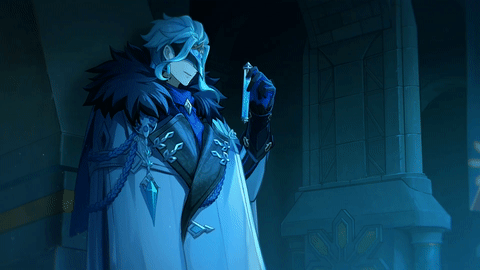
P.S. Share your takes/ thoughts in comments if you wish! I’d love to discuss tee hee💛 And now, I’ll go watch Zydrate edits of him since they flooded my tiktok fyp fhsksksk. Also, excuse if my writing seems kinda funky and hard to understand, I was writing this at 2 am🤠
#dottore#fatui genshin#genshin headcanons#genshin impact#fatui headcanons#fatui astrology#genshin astrology#genshin natal charts#dottore astrology#fatui harbingers#genshin dottore#astrology#natal chart#childe#la signora#scaramouche#arlecchino#genshin impact pierro#fatui smut#dottore x reader#dottore smut#SoundCloud
136 notes
·
View notes
Note
Saw the post that mentioned samhain and wanted to toss in some info (if you ever wanted more info about it, because I don't do discourse on tumblr) from a recent info thing I put together recently, because this misconception with the samhain debate drives me nuts
Samhain was a harvest festival that marked the start of the dark half of the year. Along with its springtime counterpart Beltane (which marked the growing season/light half of the year), it was announced based on the weather and was facilitated by and only by the Druids, a blood-identity pagan religion of upper class priests.
Samhain would be announced whenever the weather got cold enough. It was sometimes in early October or late September. It was sometimes in early November.
October 31st was never a thing for Samhain because the date always varied, and because the Druids, being Celts and existing before the Roman occupation of their lands, didn't use the Roman calendar nor did they use our modern Julian calendar.
You'll also hear how the Celts had a celebration on the last day of October unrelated to Samhain. This is true; on the last day of almost every month they had a minor celebration. Again, keep in mind too that the date was particular to the way their own culture counted months, not how Rome did it back then nor how we do it now.
it's true that the idea of "baptizing" traditions and holidays isn't unheard of when people and cultures convert from one religion to another. What's good to note is that this is not a forced thing, the baptizing of traditions; it's a practice that embraces older traditions and doesn't eradicate them. Conquerers would just eradicate them.
Technically, it is possible that the original date of All Saints got its chosen date, May 13th, via baptism of Lemuralia, a Roman holiday where spooky stuff happened regarding spirits and the dead. Christians instead chose to celebrate the joy of the Saints in heaven, because Jesus defeated death and the gates of hell won't prevail, etc, then the pope made stuff official calendar-wise.
However, when it comes to the Samhain debate, it's a myth that the Church picked that date to overtake it. Pope Gregory III switched up the date of All Saints in the 700s to commemorate a new oratory (special chapel) at the Old St. Peter's Basilica that was built to honor the saints and martyrs.
At a time when there were pagan religions and holidays all over the place, to try and outdo one harvest festival of one religious cult in the far north of the known world thousands upon thousands of miles away from Rome and Constantinople simply wasn't a reason to change an established date of a major, international, intercontinental religious celebration.
Most of these myths, along with a romanticizing of pagan religions much like modern-day's romanticizing of Norse religions and wiccan stuff, arose in England and Western Europe during the 1600 - 1700s by anti-Catholics and misinformed historians/the wealthy.
Anon I just want you to know that I am your biggest fan
Also, how did I not know it was called baptizing traditions/holidays??? That’s so awesome and I love it???
Thank you so much, this is so well put together and honestly kind of better than my post lmao
17 notes
·
View notes
Text
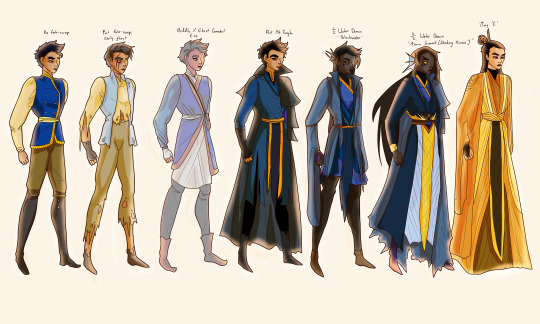
the many faces of daniel webster tgcfu au
pre-fate swap: highly loving family, beloved fiance and brother, lucky law student, much oratorial potential, aspiring lawyer and future god. respectable, rich, yet simplistic blue outfit
post-fate swap: like destroyed and all hopes crushed and family killed, fueled with vengeance. tattered clothing from prison years
post-biddle, pre-tonglu: nick biddle fixed him up again by taking the man into his rundown shack, taught him a variety of cool tricks and strategies for mt tonglu to help him survive in there ( which was how he was able to get in so quickly ). simple, if faded, clothing is worn. a pouch containing necessary material for surviving tonglu and cannibalising fellow ghosts
post-tonglu: determined, newly supreme, has calmed down since his early ghost years, calculated his totally non-haywirable plan for exactly vengeance against the water master. eyes changed to reflect the ghost king status. darker clothes as symbolism, a developed aesthetic. the edges of his clothes are tattered due to water contamination
water demon form ( one ): early tyrannical blackwater island ruler days. he makes the creepiest water demon aesthetic he can think of ( emo fish man ) in order to scare other ghosts into submission.
water demon form ( two ): a revamped version of the original water demon form. mortal spellcasters and (demonic*) cultivators usually imagine this version to call upon to wreck havoc on their enemies. more elaborate clothing to signify the Status and Power and Reverence one should Rightfully have for one of the Four Calamities
mingyi: casual friday wear ( wearing black work clothes under the orange ) hey what's the earth master doing here?
#daniel webster#fanart#my art#tgcfu au#water demon form two also counts as femster i think#dw definately has way more than seven skins to wear though#like at least twelve. the van buren interrogation drawing has fem!mingyi!ster in Actual Work Clothes#henry clay WISHES he got biddle's advice in time...
6 notes
·
View notes
Text

Saint Joseph's Oratory, Montreal
19 notes
·
View notes
Note
Hey @juniperhillpatient I’ve got another ask for ya
So today I was watching clips of the TVDU and came across this quote below.
Haley asked Klaus why he paints, and he answers thusly
“Painting is a metaphor for control. Every choice is mine, the canvas, the color. As a child I had neither a sense of the world nor my place in it, but art taught me that one’s vision could be achieved with sheer force of will. The same is true of life. Provided one refuses to let anything stand in one’s way.”
-Klaus Mikaelson
The quote reminds me of my own personal headcanon about “artist Azula”. Her life was dictated by others from all we’ve seen. Most especially by Ozai. Along with the other trappings and expectations of royalty. Lo and Li’s training of Azula, until she reaches perfection and having “not one hair out of place” come to mind especially.
Azula approached Fire bending with a single-minded determination. Worked at it, and controlled her own destiny. Being one of the most powerful fire benders alive by the time the series rolls out.
This discipline allowed Azula to attain her fabled blue flames. To control her own abilities, and exceed any expectations thrust on her.
Another example could be when Azula tried to balance being commander and friend both with Mai and Ty Lee. Believing that she was doing so adequately and was in control of the situation. Until the Boiling Rock and her friend’s betrayal (though understandable, Mai and Ty Lee actions still leave a bad taste in my mouth).
It also reminded me of your wizards of waverly place Au. Where Ty Lee called Azula and Katara an “art couple”. Or even in @theowritesfiction “Azula’s kitchen nightmare”. We’re Azula is a master chef, that turns food into art. Or Katara masters the art of talking to people.
Art is the payoff of good skill from countless hours of constant repetition. Not merely paint. Art (and thus a desire for control) can be found in anything. Like martial arts, a studied topic, oratory, or even writing. Your magnum opus in Happenstance is an example of masterful art.
Anyways, this just reminded me of my little headcanon about an “artist Azula”.
Do you any similar headcanons for Azula and/or Katara?
What do you think about Azula and her relationship to the nature of control? Or lack there of. In my view it can be both beneficial, but can also be exceedingly harmful as well. As shown by mental breakdown. Spurned on from being betrayed by her brother, than her friends, than abandoned and lowered in esteem by her father.
For an Azutara question, how do you think Katara could help Azula deal with her (potentially) toxic notions of control? Or vice versa, when Katara is being to controlling over certain things as well. Like say being overprotective of her loved one’s safety?
I’m sorry it’s taken me so long to answer this excellent & thoughtful ask! I think it’s because I keep wanting to have something meaningful to add but I really don’t I just enjoy your thoughts.
I don’t know if the Klaus quote above is ever what I was going for when I’ve written Azula as an artist before but reading it I could certainly see this being how Azula views art yes absolutely that makes so much sense.
I think Katara would be a totally different more chaotic type of artist. Water is the element of change & Katara is controlled but she’s also fluid & adaptable with her bending & I think that would come through in her art style.
Azula would be more focused on the technical element while Katara would be more focused on the process & less upset if her art changed from her original vision as she went.
Anyway I just love the character analysis & yeah I don’t really have anything else to add!
9 notes
·
View notes
Text
One of my fanfics is now incorrectly named. Very disappointed.
How can it be Four true original Renegades with all others being imitations if Auteur is also one of the originals. The only way this could work is if they are the Grandfather, Morbius, the Evil Renegade or the War King. Of course now that I think about it they could be one of those four? The War King partially digested by Lilith, Morbius rebuilt as a skeleton after their fall on Karn, the Evil Renegade like their older adversaries burning out their life just to live a little longer as their body rots around them. Both the Renegade, the Master and Astrolabus have be Merlin at some point. We know Auteur is not Astrolabus now (unless that Is the lies which it could be).
I still say all renegades other than the Original Four should simply be imitators (Cel oratory or accidentally). Thus I believe Auteur is one of those four. I quite like making them the Doctor or the Master. That is an intriguing idea I will have to think on that.
Yes Auteur is either the Doctor or the Master (perhaps Morbius but probably not the Grandfather.)
11 notes
·
View notes
Text
Retrograde Revision 2: Arcane Duelist

(art by NatteRavnen on DeviantArt)
And now we move on to the arcane duelist, an archetype I was somewhat dismissive of my first time writing it. However, I’d now like to take the time to look over it with fresh eyes.
The first thing I noticed looking back at this archetype is that some of it’s abilities are almost a prototype for the powers we would later see with the magus class, and overall, one could imagine this being a sort of proto-magus in general, albeit one built from a bardic perspective and origin.
Indeed, this archetype is all about using performance to bolster one’s combat prowess and that of others through the graceful dance of combat, tying into how many combat styles are almost dancelike in their motions, and in some cases, are also literally dances. “bladedancing” has long been a thing in the hobby, though others might choose to blend their combat with other performances, using song or oratory to control their own breathing, or even acting or comedy in place of dance to coordinate their movements, particularly in a way that seems deceptively graceless in the latter case.
Additionally, these mystical duelists learn arcane secrets to briefly enchant their blade similar to the way a magus does, but theirs only lasts as long as they maintain it, making it mostly useful in short bursts.
Honestly, now that we have the benefit of time, seeing how this archetype might relate to the magus class in terms of theory and expression could be very fun to explore.
At the most basic level, these bards learn how to focus just enough of their magic into their weapons to help them pierce foes that resist mundane weaponry.
However, they also learn a variety of performances to enhance their ability as well. The first let them call out a rallying cry or song to bolster the spirits of allies, helping them overcome fear and despair. (technically there is nothing explicitly call a “despair effect” in Pathfinder, but we can assume this is things similar to doom or the crushing despair spell).
The second, however, is the real meat of the class, letting them enhance their own weapon, be it melee, ranged, or even an appendage, with magical power, even tailoring the effects from a short list.
Among the most powerful, however, can grant this magical blessing to allies as well, albeit with reduced potency the more allies they bolster the weapons of this way.
These duelists also learn various combat techniques, specifically drawing upon those that make them effective against other casters in close quarters as well as those that help them break the defenses of especially tough creatures.
Additionally, they invest power into their weapon to make it a bonded item similar to that which a wizard uses, letting them cast one extra spell from their arsenal that day, and of course letting them enchant it without other training.
They also slowly learn how to cast effectively while wearing heavier and heavier armor, allowing many such duelists to become as armored warriors while still retaining their magical ability.
This archetype is interesting in how it sets up many of the abilities we see in magus class, and if you wanna just say that magus replaces arcane duelist that is perfectly fine, but I think there is still a place for it at the table. If you do decide to utilize it, I would recommend taking extra performance a few times so that have plenty of daily rounds for your weapon enhancing. However, remember that this does not replace the classic Inspire Courage/Competence/Heroism and so on performances, so you can easily switch between personal buffing and buffing the whole party as needed, perhaps reserving the weapon enhancement for when they actually get involved in duels or other one-on one fights. Also, don’t forget that their bonus feats are heavily geared towards being anti-caster, making them useful for singling out and disrupting spellcasting enemies.
In a way, this archetype also taps into the dilletante aspect of the bard, as we can see aspects of wizardry and what would become the magus in them. They might belong to a dedicated style that blends these things together, or they might be unique individuals with their own reasons and history for blending these aspects. All of which are interesting questions to ask about the character and the setting around them.
The so-called “chaplains” of the orc nation of Golvakk are not affiliated with any religion at all, but are master arcane duelists, bellowing out war-cries to their bloodthirsty gods, bolstering warbands such as the one that now looms on the hills above Golvakk’s verdant coastal nation, Irdiz, where the heroes have been acquiring the favor of the king. They must fight if they hope to continue swaying him.
Hardgg Oakbreaker is the last of his clan, an ancient dwarven lineage stretching back hundreds of years, reknowned for their skill in fighting surface elves and drow. After the shaky alliance with the elves solidified, the Oakbreaker prestige shriveled, now regulated to defending against drow incursions from below. He won’t speak of the rest of his clan, except to say that they have perished, and has been seen headed towards elven lands. Is the old soldier returning to the sites of old battles to reminisce, or does he have something darker and more foolish in mind?
Rumor on the Bitter Coast speaks of a strange masked man wearing mithral armor and wielding both magic and longsword together. They say he travels up and down the coast, hunting down criminals, his every clever quip seeming to make his blows bite deeper. Who is this mysterious man, and why is he never in the same place as the local merchant lord?
11 notes
·
View notes